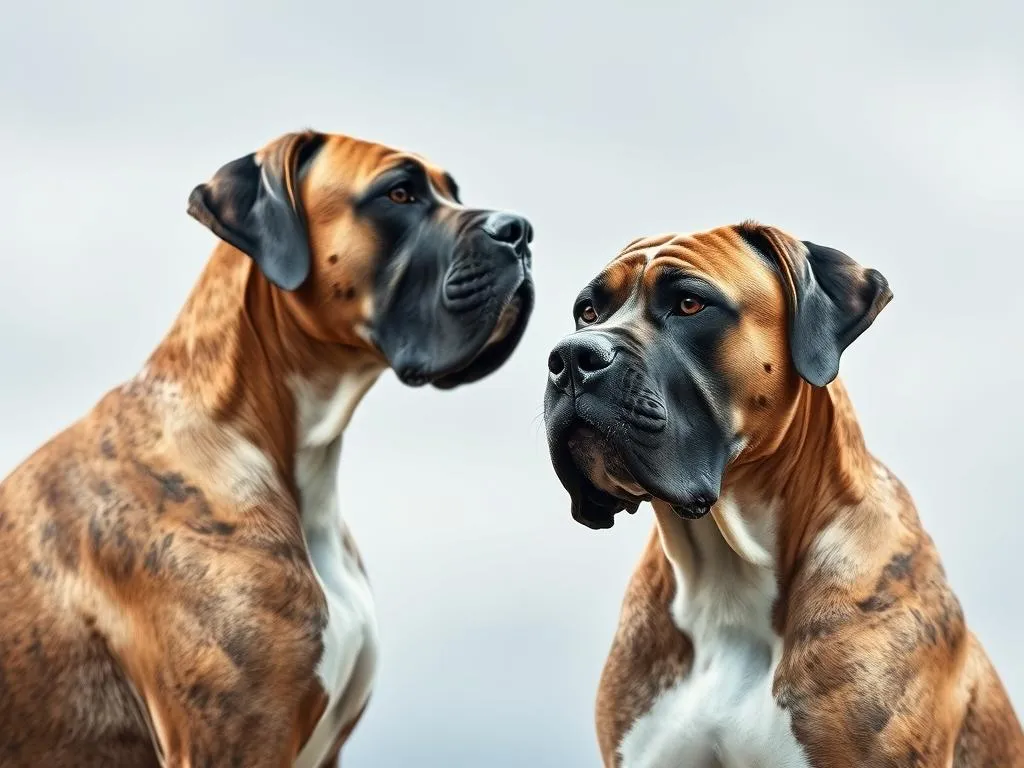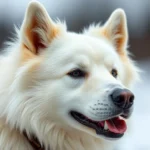
Large dog breeds have gained immense popularity among dog enthusiasts due to their majestic presence and loving nature. Two of the most notable giants in the canine world are the Great Dane and the Mastiff. Understanding the differences and similarities between these breeds is essential for potential dog owners looking for the perfect companion. This article will provide a detailed comparison of these two breeds, covering aspects such as history, physical characteristics, temperament, health, exercise needs, training, living conditions, and costs of ownership.
General Overview of Great Danes and Mastiffs
History and Origin
Great Danes originated in Germany and were initially bred for hunting large game, such as boars. Their powerful stature and keen instincts made them excellent hunting companions. Over time, they also became known as gentle giants, valued for their loyalty and companionship.
On the other hand, the Mastiff is one of the oldest dog breeds, with a history that dates back to ancient civilizations. They were utilized in wars, guarding properties, and as companion animals. Their imposing size and strength made them formidable protectors, and their loyalty is unwavering.
Physical Characteristics
Great Danes are known for their impressive height, often standing between 28 to 34 inches at the shoulder. Weighing anywhere from 100 to 175 pounds, they are one of the tallest dog breeds. Their coat comes in various colors and patterns, including fawn, brindle, blue, and black.
Mastiffs, while shorter than Great Danes, are stockier and can weigh between 120 to 230 pounds. Their height generally ranges from 24 to 30 inches at the shoulder. Mastiffs have a distinct appearance characterized by their broad heads and muscular build, with a short coat that comes in shades of fawn, apricot, or brindle.
Temperament and Behavior
Great Dane Personality Traits
The Great Dane is often described as a friendly and affectionate breed. They are known for their gentle giant demeanor, making them excellent companions for families. Great Danes typically get along well with children and other pets, displaying patience and kindness.
Mastiff Personality Traits
Mastiffs tend to be loyal and protective, forming strong bonds with their families. They are often reserved around strangers, making them excellent watchdogs. While they can be somewhat aloof, their affectionate nature shines through with their loved ones. Socialization from a young age is essential to ensure they are well-adjusted.
Comparing Temperament
In various situations, Great Danes tend to be more sociable and outgoing, while Mastiffs may appear more reserved and protective. Both breeds can exhibit common behavioral issues such as separation anxiety, but with proper training and socialization, these can be managed effectively. Great Danes are generally easier to train due to their eagerness to please, while Mastiffs may require more patience and consistency.
Health and Lifespan
Common Health Issues
Both Great Danes and Mastiffs are prone to specific health concerns due to their size. Great Danes are particularly susceptible to bloat, a life-threatening condition that causes the stomach to fill with gas. Other common issues include hip dysplasia and certain heart conditions.
Mastiffs, on the other hand, often face health challenges such as elbow dysplasia, obesity-related issues, and skin problems due to their loose skin folds. Regular veterinary check-ups are crucial for early detection and management of these conditions.
Lifespan Expectations
The average lifespan of a Great Dane is around 7 to 10 years, while Mastiffs tend to live a bit longer, averaging 8 to 12 years. Factors influencing the health and longevity of both breeds include genetics, diet, and overall care.
Preventive Care and Vet Visits
Routine veterinary care is vital for both breeds. Regular health screenings, vaccinations, and preventive medications can help ensure a longer, healthier life. Owners should be proactive in monitoring their pets’ health and addressing any concerns promptly.
Exercise and Grooming Needs
Exercise Requirements
Both breeds require regular exercise, but their needs differ. Great Danes thrive on daily walks and playtime, requiring at least 30 to 60 minutes of exercise each day to maintain a healthy weight and mental stimulation.
Mastiffs have lower energy levels and may require less exercise, typically needing around 30 minutes of moderate activity daily. They enjoy leisurely walks and playtime but can be more prone to overheating due to their bulk.
Grooming
In terms of grooming, Great Danes have short coats that shed moderately, requiring brushing once a week to manage loose hair. Bathing should be done as needed, usually every few months unless they get particularly dirty.
Mastiffs also have short coats but require special attention due to their skin folds. Regular brushing is essential to keep their skin healthy, and they should be bathed occasionally to prevent odor and skin issues.
Comparing Exercise and Grooming
The exercise and grooming needs of both breeds can significantly impact potential owners’ lifestyles. While Great Danes may require more active engagement, Mastiffs may fit better into a more relaxed routine.
Training and Socialization
Training Techniques
When it comes to training, Great Danes respond well to positive reinforcement techniques. They are intelligent and eager to please, making them relatively easy to train. Consistency and early training are essential to prevent any behavioral issues.
Mastiffs can be a bit more stubborn, requiring firm and consistent training methods. They respond best to calm, assertive leadership and may benefit from early exposure to various environments and situations.
Socialization Importance
Socialization is critical for both breeds to ensure they grow into well-adjusted adults. Great Danes should be exposed to different people, pets, and environments from a young age to prevent shyness or fearfulness.
For Mastiffs, early socialization is even more crucial due to their protective instincts. Exposing them to various situations can help them become more comfortable around strangers and different environments.
Comparing Training Needs
In terms of intelligence and trainability, Great Danes tend to excel, while Mastiffs may require more time and patience. Both breeds benefit from ongoing training and socialization throughout their lives.
Living Conditions and Suitability
Ideal Living Environment for Great Danes
Great Danes require ample space due to their size. They thrive in homes with large backyards but can adapt to apartment living if they receive enough daily exercise. They are indoor dogs that enjoy being part of family activities.
Ideal Living Environment for Mastiffs
Mastiffs are more adaptable to various living environments. They can live comfortably in apartments or smaller homes, provided they get regular exercise. A yard is beneficial, but their lower energy levels mean they can be content with moderate exercise.
Comparing Living Conditions
When considering living conditions, both breeds can be suitable for various home environments, but potential owners should consider their exercise needs and space requirements when making a decision.
Cost of Ownership
Initial Costs
The initial costs of owning a Great Dane or Mastiff can vary. Purchase prices for both breeds can range significantly depending on breeder reputation and lineage. Adoption fees may be lower but still vary by organization. Initial supplies such as food, a crate, toys, and grooming tools can add to the cost.
Ongoing Expenses
Ongoing expenses include food, grooming, veterinary care, and potential health issues. Great Danes typically require more food due to their size, while Mastiffs may incur higher vet bills due to their predisposition to certain health conditions.
Long-term Financial Considerations
Budgeting for each breed’s needs over time is crucial. Owners should prepare for the costs associated with grooming, vet visits, and food, as well as any unexpected health issues that may arise.
Conclusion
In summary, both the Great Dane and Mastiff offer unique qualities that can make them wonderful companions. The Great Dane is known for its friendly demeanor and sociability, while the Mastiff embodies loyalty and protectiveness. Understanding the differences and similarities between these two breeds is essential for potential dog owners to make informed decisions.
When choosing between a Great Dane and a Mastiff, consider your lifestyle, living space, and personal preferences. Each breed has its own set of needs, and selecting the right one can lead to a fulfilling and happy companionship.
FAQs
Which breed is better for first-time dog owners?
Both breeds can be suitable for first-time dog owners, but Great Danes are often easier to train and socialize, making them a popular choice for those new to dog ownership.
Are Great Danes or Mastiffs better with children?
Both breeds tend to be gentle with children. However, Great Danes are often more playful and sociable, while Mastiffs may be more protective and reserved.
What are the most significant health concerns for each breed?
Great Danes face issues like bloat and heart conditions, while Mastiffs are prone to elbow dysplasia and obesity-related problems.
How much exercise do Great Danes and Mastiffs need?
Great Danes typically require 30 to 60 minutes of exercise daily, whereas Mastiffs need around 30 minutes of moderate activity.
Can Great Danes and Mastiffs live in apartments?
Yes, both breeds can live in apartments, but Great Danes require more exercise while Mastiffs are generally more adaptable to smaller spaces.









